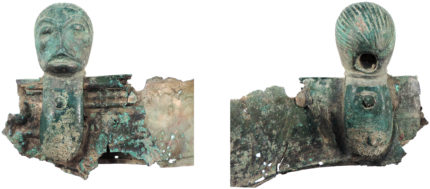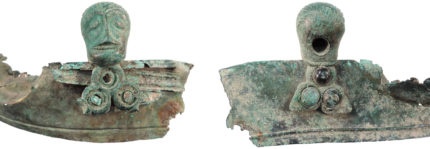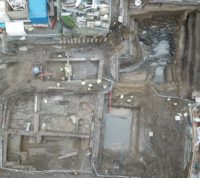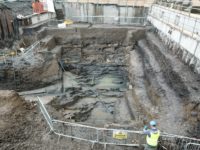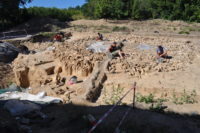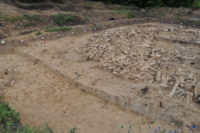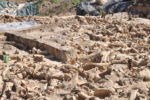On topic news is a little thin at the moment, so I shall fill the lull with the Høylandet tapestry, a Norwegian embroidered church tapestry from the late 1100s that is the only known surviving tapestry of its kind.
We know from contemporary sources that medieval churches in Norway were draped with textiles and tapestries. This was not only a decorative and devotional statement; swathing the interior of a church in textiles helped insulate the frigid building in the long winters. The church tapestries were made of wool and plant and mineral dyes were susceptible to damage, fading and decay. Even though they were extremely popular in the Middle Ages, the ones that did manage to survive the elements were systematically destroyed and recycled after the Reformation. Other than the Høylandet tapestry, only small fragments of embroidery have been found in archaeological explorations of medieval churches.
It was stitched by a group of women in the village of Høylandet in central Norway’s Trøndelag County for their parish church. This was an agricultural area, and embroidery was a high-status activity performed by women who could afford to spend untold hours putting decorative stitching on cloth instead of working with their families to bring in a harvest. First they wove a red background, then sketched Biblical scenes on it. Finally they embroidered fully realized characters onto the textile. They used yarns in a variety of bright colors — blue, green, ochre, yellow, red — to stitch the Biblical scenes. White linen thread was used for the outlines. Today the vivid colors have faded to brown shades, and coupled with the white outline, it almost has a black-figure pottery vibe.
The tapestry is no longer complete. It is 44 cm (17.3 inches) high, but however long it was originally, only 210 cm (6’11”) of that length is extant. What does remain is embroidered with three scenes: Mary sitting on a throne as Queen of Heaven with the Christ child; the Wise Men, Caspar, Melchior and Balthazar, bringing gold, frankincense and myrrh; the kings being warned in a dream not to return to Herod and report on the birth of Jesus.
It’s unknown how the tapestry made it through the Reformation. At some point it was stashed in the loft of the Høylandet Church where it was rediscovered in the 1800s. By happy accident, the church attic proved to be a fine conservation climate, keeping the large section of tapestry in excellent condition.
It is now under the care of experts at the Norwegian University of Science and Technology (NTNU) University Museum. The iconography and technique of the tapestry lends unique insight to the iconography and craft of sacred art in medieval Norway, which is why art history PhD candidate Ingrid Lunnan Nødseth is writing her dissertation on the tapestry.
“In the Høylandet tapestry we find great pattern and technique variations. For example, the horse is filled with nine different embroidery patterns. It’s embroidered with a so-called fill stitch, a technique only found in Scandinavia. It’s a sign that the work belongs to a Nordic context,” says Nødseth.
The Wise Men are also depicted differently on this tapestry than we typically see the Wise Men depicted in Western art.
In the Middle Ages, the men were portrayed as three holy kings. In the Høylandet tapestry, they are wearing short pants and robes draped over their shoulders; two of them have small crowns and one has a Phrygian hat. Their clothing shows that they have come from the East.
The textures and patterns embroidered on their clothing (and the horse’s skin!) are spectacular.



